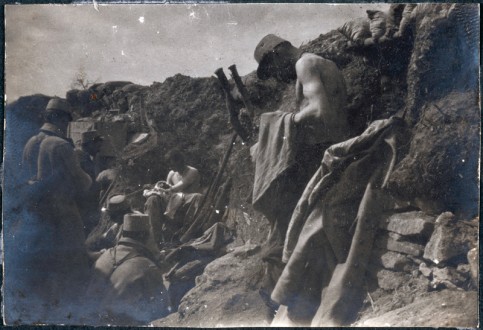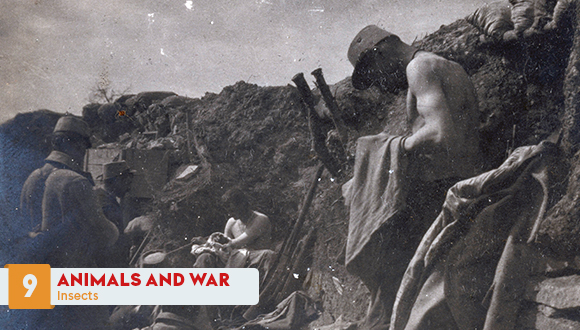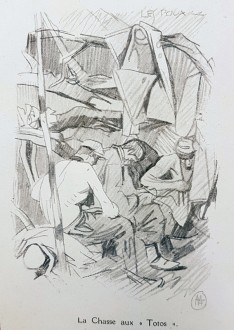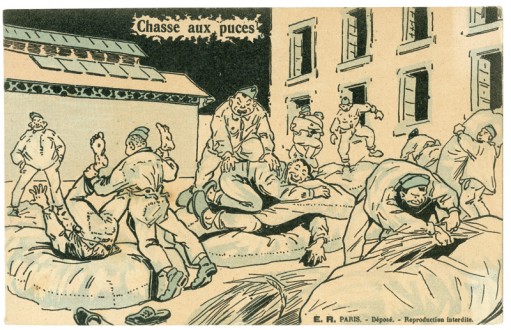
Soldiers getting rid of fleas and lice infesting their clothes and bodies. © Paris, musée de l’Armée, Dist. RMN-GP / Pascal Segrette
The 1917 issue n°18 of the French trench newspaper Ver luisant (“The Glow-Worm”), tells the story of the war through the eyes of a louse. The louse is represented sitting on a man’s head, writing its “Memoirs of a Louse. Journeys to the Front”. © Paris, musée de l’Armée
In October 1914, French artist Mathurin Méheut (1882-1958) was recalled into the 136th Infantry Regiment of Arras. From 1916 to 1917, he served in the Army’s Topographic section, responsible for the Army’s mapping, first at Sainte-Menehould and then at Bergues. “Totos’ Hunting”, one of his numerous sketches, provides a testimony to the life in the trenches. © Paris, musée de l’Armée
Humorous card entitled “Flea Hunting”. © Paris, musée de l’Armée, Dist. RMN-GP / Pascal Segrette
Insects
To their tombs…
Traces of body lice were found near the remains of soldiers of the Great Army during archaeological excavations conducted in Vilnius between 2001 and 2003. Body lice will hold on to the fibres of clothes and lay eggs there to reproduce. Lice can carry diseases such as typhus that caused the death of many soldiers and civilians accompanying the troops at the time.
Lice Hunting
During the First World War, the lack of hygiene combined with filthy conditions in the trenches lead to the multiplication of parasites such as lice and fleas but also rats. The soldiers often talked about it and tried to de-dramatize the situation with humour. The French nicknamed the parasites “The Totos”. The term was already used in several localities and social environments prior to the war, but its use became widespread with the war. It may well be that this expression makes reference to childhood and to the character many authors and cartoonists identify to the young school boy, an impertinent dunce who talks back. Hunting “Totos” is a recurring theme on the postcards sold during the Great War. For the French, the word “Toto” is assimilated to the “Boche”, a pejorative term meaning “the Germans” as it is hunted and crushed. Preventive measures were taken. The so-called “pyrethrum butter”, a strong repellent against insects, was added to the soldier’s knapsack.
Turn them into something useful
Technological developments made it possible to consider the use of parasites in a military context. For instance, research on how to use lice, fleas, ticks, bedbugs and mosquitoes in order to detect intruders was conducted by the U.S. Army Limited War Laboratory. In his book The War Animals published in 1977, scientist Robert E. Lubow reports a series of inconclusive experiments: the louse is considered too lazy and not very gifted, the chip improper because animated by an insatiable appetite, the tick unusable because it moves too silently and the bug too prone to deliver “false alarms”. There remains the mosquito that locates its prey, gets excited, flies towards it and pierces the skin with its trunk to feed itself […]. Nowadays, the development of nanotechnologies directs the search, for example, on “mosquito robots” endowed with the same displacement capacities as the insect and able to discreetly approach its target…





Ajouter un commentaire